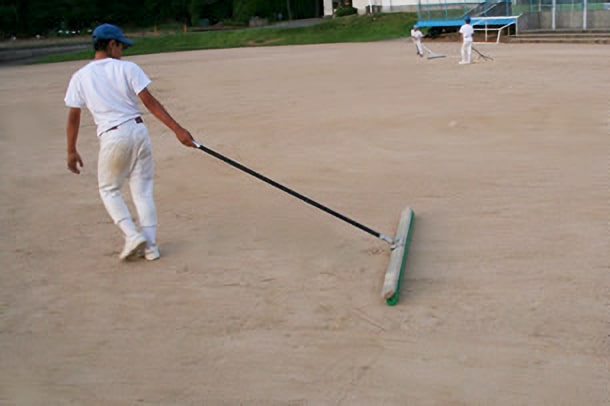
Batting technique in baseball is an important factor that determines the outcome of a game.
Batters are expected to contribute to their team by using different batting styles depending on the situation.
In this article, we will explain in detail the different types of baseball hitting techniques and their characteristics.
It covers a wide range of hitting styles, from basic techniques to applied techniques, and shows which hitting style is effective in what situation.
This will provide useful information for players looking to improve their batting skills and for fans who want to gain a deeper understanding of baseball.
First, let’s look at the basics of how to hit a baseball.
目次
Basic baseball hitting techniques
Batting technique in baseball is an important factor that determines the outcome of a game.
Batters are expected to contribute to their team by using different batting styles depending on the situation.
Here we will take a closer look at the basics of how to hit a baseball.
First of all, it is important to understand the basics of a full swing and the characteristics of a compact swing.
The basics of a full swing
A full swing is the basic way to hit the ball powerfully.
This swing is especially used when aiming for long hits or home runs.
Understanding the fundamentals of a full swing and executing it properly will help you grow as a hitter.
-
Stance and Grip :
- Proper stance and grip are important in preparing for a full swing. Your stance should be slightly wider than shoulder width, and you should maintain a stable posture. Your grip should be firm and evenly distributed on the bat.
- The key to gripping the bat is to start in a relaxed position in order to apply force, and then grip it firmly at the moment of swing.
-
Swing Path :
- In a full swing, the trajectory of the bat is important. Pull the bat back and start the swing smoothly. The trajectory of the swing should not be horizontal, but should be slightly upwards to give the ball an appropriate angle.
- Maintain balance throughout your swing to deliver maximum power at impact.
-
Lower body movements :
- The movement of the lower body is essential to a powerful swing. As you start the swing, you transfer your weight from your back foot to your front foot, and transmit the power of your entire body to the bat.
- Step with natural foot movements, being conscious of the coordination between your upper and lower body.
-
finish :
- Be careful not to lose your balance when finishing your swing. Swing the bat firmly through, and adjust your posture after the swing.
- The finishing position should be with the bat over your shoulder, ending with a natural movement.
Features of compact swing
A compact swing is a way of hitting the ball with precision.
This swing is used especially when trying to hit or for situational plays.
Compared to a full swing, this style of hitting emphasizes accuracy over power.
-
Stance and Grip :
- A compact swing involves taking a slightly narrower stance. Keep your stance shoulder-width apart and maintain a stable posture. Hold the club lightly and in a relaxed position.
- The key to gripping the bat is to start in a relaxed position, just like a full swing, and then grip it firmly at the moment of impact.
-
Swing Path :
- In a compact swing, it is important to swing the bat quickly and with a short trajectory. The start of the swing is small and the power is concentrated at the moment of impact.
- Keep the bat’s trajectory as close to horizontal as possible, and focus on swinging it through to the ball in the shortest distance possible.
-
Lower body movements :
- Even with a compact swing, the movement of the lower body is important. Weight transfer is small and quick steps are used to respond to the ball.
- Keep your foot steps to a minimum and be conscious of the coordination between your upper and lower body.
-
finish :
- Be careful not to lose your balance when finishing your swing. Swing the bat firmly through, and adjust your posture after the swing.
- The finishing position should be with the bat over your shoulder, ending with a natural movement.
By understanding these basic hitting techniques and using them appropriately according to the situation, you can improve your hitting technique.
Next, let’s take a closer look at the most common types of shots.

Typical types of hitting
There are many different types of hitting techniques in baseball, and it is important to choose the appropriate hitting style depending on the situation.
Here, we will explain in detail about line drive hits and ground ball hits, which are two of the most common hitting styles.
Line Drive Hit
A line drive hit is a ball that flies low and with a lot of force.
This is a very effective hitting technique because it makes it easier for the ball to get between the fielders and result in a hit.
Here are some basic tips for hitting a line drive:
-
Swing Path :
- The trajectory of the swing is important to hit a line drive hit. You need to swing the bat at a nearly horizontal angle and hit the ball straight.
- At the moment of impact, the face of the bat should be vertical to accurately hit the ball. At this time, avoid excessive upward or downward swings and aim for a horizontal swing.
-
Lower body movements :
- To hit a line drive, it is important to have stability in your lower body. Transfer your weight smoothly and keep your center of gravity firmly on your front foot.
- As you start your swing, you can shift your weight from your back foot to your front foot to hit the ball with force. Take small steps and swing while maintaining your balance.
-
Gaze and timing :
- To hit a line drive, your line of sight and timing are important. Look closely at the pitcher’s hands and confirm the release point of the ball.
- You need to judge the exact moment the ball leaves your hand and start your swing with precise timing – not too early and not too late.
-
Wrist usage :
- By using your wrists flexibly during the swing, you can improve your bat control. It is important to make your wrist movements smooth and firmly catch the ball at the moment of impact.
- If your wrists are too rigid, your swing will be stiff, making it difficult to hit the ball sharply, like a line drive.
Ground ball hit
A ground ball hit is one in which the ball rolls along the ground.
This hitting style makes it easy to target gaps in the defense and is especially effective in hit-and-run and bunting situations.
Here are some basic tips for hitting a ground ball:
-
Swing Path :
- To hit a ground ball, you need to have a slightly downward batting trajectory, swinging to hit the top of the ball and letting it roll towards the ground.
- At the moment of impact, the bat should be swung down to give the ball the right amount of spin, which will allow the ball to roll along the ground.
-
Stance and Grip :
- Take a slightly narrower stance to maintain a stable posture. Grip the bat lightly, then grip it firmly at the moment of swing to improve bat control.
- By sitting low at the plate and placing your center of gravity slightly forward, it will be easier to transfer power to the ball.
-
Ball identification :
- To hit a ground ball, it is important to accurately judge the trajectory of the ball. Look closely at the pitcher’s hands and predict when the ball will come.
- Aim for a low ball and try to hit the ball towards the ground.
-
Foot movement :
- The movement of your feet is also an important factor. Transfer your weight smoothly from your back foot to your front foot and time your swing accordingly. Take small steps and swing while maintaining your balance.
- Start your swing by lifting your front foot slightly to get the ball rolling towards the ground.
-
Strike objective :
- Ground ball hits are effective, especially when there are runners on base. Hit and run attempts and bunting require you to target gaps in the defense.
- By rolling the ball into a position that makes it easy for runners to advance, you can increase your team’s chances of scoring.
By understanding these typical hitting techniques and using them appropriately, you can improve your hitting technique.
Next, let’s take a closer look at power hitting and its techniques.

Power hitting and its techniques
Power hitting is a batting technique in baseball that aims for long hits and home runs.
To hit the ball hard, you need proper swing technique and strength training.
Here we will explain in detail about the swing required to hit a home run and the strength training required for power hitters.
Swinging for a home run
A swing aimed at hitting a home run requires strength and accuracy.
By mastering the proper swing technique, you can hit the ball farther.
-
Stance and Grip :
- The stance for hitting a home run should be slightly wider than shoulder width, which will increase the stability of your body and allow you to maximize the power of your swing.
- The grip is firm and holds the bat in place. Strengthening your grip improves your control of the bat during your swing.
-
Swing Path :
- When swinging to hit a home run, the trajectory of the bat is important. Swinging the bat slightly upwards gives the ball the right angle to hit high and far.
- The goal is to perform a continuous series of movements from the start of the swing to impact, thereby exerting maximum power at the moment of impact.
-
Lower body movements :
- The movement of the lower body is essential for a powerful swing. The weight must be transferred smoothly from the back foot to the front foot, and the power of the whole body must be transmitted to the bat.
- As you start your swing, bend your back knee slightly and shift your weight onto your front foot to generate explosive power.
-
Moment of impact :
- At the moment of impact, it is important to hit the ball with the center of the bat. By hitting the center of the ball with the bat, you can get the maximum distance.
- At impact, use flexible wrists to transfer maximum speed and power to the bat.
-
finish :
- Be careful not to lose your balance when finishing your swing. Swing the bat firmly through, and adjust your posture after the swing.
- The finishing position should be with the bat over your shoulder, ending with a natural movement.
Strength training for power hitters
To achieve power hitting, proper strength training is necessary.
Strengthening your muscles will help you swing more powerfully and hit the ball farther.
-
Upper body strength training :
- Strengthening your upper body will improve your swing power, especially your chest, shoulders and arms.
- Exercises such as bench press, shoulder press, and arm curls are incorporated to strengthen the muscles of the entire upper body in a balanced manner.
-
Lower body strength training :
- To support a powerful swing, you also need strong lower body muscles, especially your quadriceps, hamstrings, and calf muscles.
- Incorporate exercises such as squats, deadlifts and leg presses to build strength throughout your lower body.
-
Core Strengthening :
- A strong core plays a key role in the stability and power transfer of your swing. A strong core keeps your swing balanced and allows you to transfer all of your body’s power efficiently to the bat.
- Incorporate exercises like planks, sit-ups and Russian twists to build core strength.
-
Increased flexibility and range of motion :
- In addition to strength, flexibility and range of motion are also important. Flexible muscles and joints allow you to swing wider and transfer more power more effectively.
- We incorporate flexibility training such as stretching and yoga to increase the range of motion of the entire body.
-
Balance Training :
- Balance training is also important to maintain balance during your swing. Training using a balance ball or balance disc can be done to improve your body stability.
- Exercises such as one-legged squats and balance ball push-ups are included to improve balance.
By incorporating these training exercises, you can improve your power hitting technique and become a stronger hitter.
Next, let’s take a closer look at the importance of contact hitting.

The importance of contact hitting
Contact hitting is the technique of hitting the ball accurately, and plays an especially important role when aiming for a single hit.
This technique is not only important for improving batting average, but also for team play.
Here we will explain in detail the benefits of single hits and how to improve your hitting technique.
Single hits and their benefits
A single hit is one of the basic batting outcomes in baseball and plays an important role in many situations during a game.
A hitter who can reliably hit singles is a valuable asset to a team.
-
Advance the runner :
- A single hit is an important way to advance a runner. Especially when there is a runner on base, a single hit can advance the runner to the next base, putting the runner in scoring position.
- For example, if there is a runner on second base, a single hit can bring the runner home and score a valuable run.
-
Improved on-base percentage :
- By hitting a single, a batter can improve his or her own on-base percentage. A batter with a high on-base percentage increases the team’s offensive power and increases scoring opportunities.
- A high on-base percentage puts pressure on the opposing pitcher and creates an advantageous situation for the next batter.
-
Breaking down the defense :
- Single hits can also disrupt the opposing team’s defense. In particular, a precise hit that goes through the gaps between the infield and outfield can disrupt the teamwork of the defense.
- Disorganized defense leads to errors and opportunities for additional bases, expanding offensive chances.
-
Stable Hitting :
- The technique of hitting a single hit is also proof of stable hitting power. Hitting with constant awareness of contact directly leads to an improvement in batting average and allows you to perform consistently throughout the game.
- Stable batting will increase the confidence of the entire team and become the core of the attack.
How to improve your hitting technique
Specific training and practice are required to improve your ability to hit the ball accurately.
Here are some ways to improve your hitting technique:
-
Tee batting :
- Tee batting is a practice where you hit a stationary ball. This allows you to check the trajectory and timing of your swing and hone your ability to hit the ball accurately.
- In tee batting, balls are set at various heights and positions, allowing students to practice hitting the ball accurately on any course.
-
Soft Toss :
- Soft toss is a practice in which you hit a ball that is lightly thrown from a short distance. This practice develops your ability to react to the ball in real time and swing at the right time.
- By changing the speed and angle of the ball, you will develop the ability to adapt to a variety of pitches.
-
Batting cage practice :
- In the batting cage, pitching machines are used to practice hitting balls of various speeds and trajectories, allowing players to practice batting in an environment similar to that of a real game.
- In particular, it trains your reaction to fastballs and curveballs, improving your ability to respond in actual games.
-
Eye Training :
- Visual training is also important to hit the ball accurately. Through vision tests and eye training, you will develop the ability to judge the ball.
- In particular, by watching the pitcher’s hands closely, you can accurately determine the ball’s release point.
-
Video Analysis :
- We will improve your technique by filming and analyzing your hitting form on video. We will check the swing trajectory, timing, body movement, etc. in detail to identify areas for improvement.
- You’ll watch videos with your coaches and teammates and get feedback to hone your skills.
-
Mental Strengthening :
- Strengthening your mental state is also important to hitting the ball accurately. We provide training to improve concentration and mental care to help you overcome pressure.
- It is effective to incorporate relaxation techniques and positive self-talk to reduce tension during a match.
By incorporating these methods, you can improve your contact hitting technique and achieve consistent hitting during matches.
Next, let’s take a closer look at the different types of bunts and how to use them.

Types of Bunts and How to Use Them
Bunting is an important tactic in baseball and has the power to change the flow of a game.
There are many different types of bunts, and each one should be used according to the situation.
Here we will explain in detail about the safety bunt and the suicide squeeze, and introduce their respective tactics and methods for success.
Safety bunt tactics
A safety bunt is a tactic that uses a bunt to try to get on base.
This tactic is particularly effective against speedy runners and can be successful when it exploits gaps in the defense.
Here are some basic points and tactics for a safety bunt:
-
Bunting Position :
- When performing a safety bunt, it is important to take the correct bunting position. Keep the bat level and make sure you have your eye on the ball you are bunting.
- Grip the bat lightly, keep your wrist flexible, and move the bat in line with the ball. When bunting, point the tip of the bat slightly upwards to help the ball roll toward the ground.
-
Stance and Grip :
- Your stance should be shoulder-width apart and your center of gravity should be slightly forward, allowing you to get off to a quicker start and making it easier to get on base after bunting.
- By holding the grip lightly and then gripping it firmly at the moment of bunting, you can improve your control of the bat.
-
Bunt Course :
- The point of a safety bunt is to roll the ball between the infielders, especially between the pitcher and third baseman or the pitcher and first baseman.
- When bunting, you adjust the speed of the ball and the angle of your bat to keep the ball from rolling too quickly, making it harder for the defense to handle.
-
Runners start :
- A quick start after bunting is essential to the success of a safety bunt. At the moment of bunting, shift your weight forward and start running quickly toward first base.
- Runners aim for the base while gauging the opponent’s defense’s movements. The key to success is to create a situation in which the opponent has difficulty handling the bunt.
How to succeed with the suicide squeeze
A suicide squeeze is a tactic in which a runner runs from third base to home plate and the batter manages to bunt to score.
This tactic is risky, but it can definitely add up to some points if you succeed.
Below are some basic points about the suicide squeeze and how to do it successfully.
-
Bunt Timing :
- The timing of the bunt is crucial to the success of the suicide squeeze. The batter must time his bunt precisely because the runner will be starting from third base in time with the pitcher’s throwing motion.
- When bunting, the batter must extend his bat just before the ball reaches the catcher’s mitt in order to bunt the ball safely.
-
Bunt course and direction :
- In a suicide squeeze, the ball is ideally rolled in front of the pitcher, giving the runner time to make a run for home plate while the pitcher takes his time to process the play.
- When bunting, angle the bat slightly upwards to allow the ball to roll more slowly towards the ground, which will increase the chance of a successful bunt.
-
Runners starting and sliding :
- The key to the success of a suicide squeeze is the start of the runner on third base. It is important to judge the pitcher’s throwing motion and start at the optimal timing.
- The runner must sprint toward home plate and slide in before the catcher can get to the ball, with timing and technique of the slide being key to success.
-
Communication and Signs :
- Executing a suicide squeeze requires perfect communication between the batter and the runner, not missing any signs and executing the tactic with precision.
- If signs are overlooked or misunderstood, bunts or runners’ starts will be delayed, increasing the risk of failure.
-
Analysis of pitcher tendencies and weaknesses :
- In order to make a suicide squeeze successful, it is important to analyze the tendencies and weaknesses of the opposing pitcher. In particular, targeting pitchers with a slow quick motion or pitchers with poor control will increase your chances of success.
- He assesses the opposing pitcher’s movements and launches a suicide squeeze at the optimal timing.
By keeping these points in mind, you can use bunting tactics effectively and turn the tide of the game in your favor.
Next, let’s take a closer look at the special techniques and how to use them.

Special techniques and their use
In baseball, there are special batting styles that can be used depending on the situation of the game and the opposing team’s defense.
By mastering these techniques, you can broaden your attacking options and contribute more to your team.
Here we will explain in detail the advantages of push bunting, drag bunting, and switch hitting.
Push bunts and drag bunts
Push bunts and drag bunts are special hitting techniques that apply bunting techniques.
These batting techniques are effective when trying to exploit gaps in the opponent’s defense and get on base.
-
Pushbunt :
- A push bunt is a hitting technique in which you bunt the ball while applying force to the bat to make it roll further away. This technique is effective when the defense is moving forward.
- Stance and grip : Stand slightly wider than shoulder width and hold the bat lightly. Hold the bat horizontally and move the bat as if pushing it out lightly at the moment of bunting.
- Bunt course : The aim is to roll the ball between the pitcher and the infielders. Put force on the bat to make the ball roll faster. It is important to roll the ball to a position where the defense cannot catch up.
- Runner’s Start : At the moment of bunting, shift your weight forward and start running quickly towards first base. This is especially effective for speedy runners, aiming to get on base while the defense is busy handling the ball.
-
Drag Bunt :
- A drag bunt is a hitting technique where the bunt player pulls back on the bat to gently roll the ball. This technique is effective when the defense is backing away.
- Stance and grip : Take a slightly narrow stance and hold the grip lightly. Hold the bat horizontally and pull the bat back at the moment of bunting to roll the ball.
- Bunt course : The aim is to slowly roll the ball in front of the pitcher or infielder. Pulling the bat back will make the ball roll slowly, placing it in a position where the defense cannot catch up.
- Runner’s start : At the moment of bunting, the runner shifts his weight forward and starts running quickly toward first base. The runner aims to reach base while the defense is busy processing the ball, so the position and speed of the bunt are important.
Advantages of switch hitting
Switch hitting is a technique that allows a batter to hit from both sides of the plate (right and left).
This technology allows players to choose advantageous at-bats depending on the opposing pitcher’s handedness, expanding the range of their attacks.
-
Advantageous at bat against pitcher :
- A switch hitter can choose to bat depending on the handedness of the opposing pitcher. By batting right-handed against a left-handed pitcher and left-handed against a right-handed pitcher, he can create an advantageous situation.
- When a pitcher throws a ball toward the body, the batter can see and react to it more easily, which can lead to improved batting averages and on-base percentages.
-
Breaking down the defense :
- Switch hitting can also put pressure on the defense, as the defensive formation changes depending on which side the batter is at bat, making the defensive moves less predictable.
- Especially against a defensive team that uses a shift, changing batting positions can disrupt the shift and expand the hitting zone.
-
Improved striking balance :
- Switch hitting also contributes to improving the balance of your hitting. By hitting from both bats, you can balance your swing from left to right and improve the stability of your hitting form.
- Through batting practice from both sides of the plate, you will hone your muscle usage and bat control techniques, improving your overall batting ability.
-
Ability to respond to pitcher changes :
- Switch hitters can also adapt flexibly to changes in pitchers during a game. When the opposing team changes pitchers, they can always maintain an advantageous position by switching batting positions.
- Especially in important situations late in the game, a switch hitter can get the advantage at bat when the pitcher is changed, increasing his team’s chances of scoring.
-
Diversify team strategies :
- The presence of switch hitting also leads to diversification of team strategies. Having a switch hitter in the batting lineup makes it difficult for the opposing team to read their strategies, and increases the variety of their attacks.
- Having a switch hitter in the lineup allows you to put pressure on the opposing pitcher and tweak the flow of the game in your favor.
By mastering these special hitting techniques, you can broaden the range of your hitting techniques and increase your opportunities to succeed in matches.
Next, let’s take a closer look at how to practice to improve your hitting technique.

How to practice to improve your hitting technique
Improving your hitting technique requires consistent practice and proper technique.
By incorporating specific training methods such as tee-ball and practical practice, you can improve the accuracy and power of your batting.
Here, we will explain in detail the effects of tee batting and the key points to keep in mind when practicing.
The effects of tee batting
Tee batting is a practice method in which you set the ball on a tee and hit it, and is very effective for solidifying the basics of batting technique.
Through this practice method, you can accurately grasp and improve your swing trajectory and timing.
-
Check your swing :
- In tee batting, you hit a stationary ball, so it’s easier to check your swing. You can closely check the trajectory of your swing and how you swing the bat, and master the correct form.
- You can also use a mirror or videotape your swing for a more detailed analysis.
-
Improved hitting ability :
- Tee batting is a great way to develop the ability to hit the ball accurately, especially in terms of catching the ball with the center of the bat.
- The ball is set at various heights and positions, and students practice hitting the ball accurately on any course. This will allow students to respond to a variety of pitches during a match.
-
Mastering Timing :
- Tee batting also helps you master the timing of your swing. You practice starting your swing at the right time, in line with the ball’s position, and transmitting maximum power at the moment of impact.
- In particular, to improve your ability to respond to curveballs, you will hone your sense of timing by adjusting the position of the ball and the timing of when you start your swing.
-
The importance of repetition :
- Tee batting is a great way to practice repetition, as repeating the same movements will improve the consistency of your swing and help you develop accurate hitting technique.
- By incorporating tee batting into your daily practice routine and repeating it a certain number of times, you can develop a swing habit and improve your technique.
Key points in practical training
Practical practice is conducted based on actual match situations and is an essential element for further improving hitting techniques.
Below are detailed explanations of key points in practical training.
-
Live Pitching :
- Live pitching, where you hit balls thrown by a real pitcher, is practice in a situation similar to a real game. It helps you develop the ability to respond to a variety of pitches, including fastballs, curveballs, and other types of pitches.
- During live pitching, you will focus on practicing hitting timing and how to use your eyes to get a feel for real-game situations.
-
Simulation games :
- By playing simulation games within the team, you can practice simulating a real game. Through comprehensive practice that includes defense and base running, you can understand not only batting but also the flow of the entire game.
- Simulation games can help you improve your ability to make decisions during matches and respond to pressure.
-
Batting cage practice :
- In the batting cage, pitching machines are used to practice hitting balls of various speeds and trajectories, allowing players to practice batting in an environment similar to that of a real game.
- In particular, it trains your reaction to fastballs and curveballs, improving your ability to respond in actual games.
-
Situational Batting Practice :
- We set up situations that are common in real games and conduct batting practice according to those situations. For example, we practice bunting with runners on base, batting with the ball in scoring position, and other specific situations.
- Through situational batting practice, you can broaden your tactics and play options during a match.
-
Mental training :
- Mental training is also important during practice, where you learn how to improve your concentration and deal with pressure during a match.
- By incorporating positive self-talk and relaxation techniques, you can strengthen your mental state and improve your performance during the game.
-
Feedback and Improvement :
- After practice, you will receive feedback from your coaches and teammates to identify areas for improvement in your hitting technique, and you will use video analysis to check and correct your hitting form.
- Continuous feedback will help you improve your technique and strike more consistently.
By incorporating these training methods, you can improve your hitting technique and maximize your performance in matches.
Through comprehensive batting practice, you will be able to step up to the plate with confidence.




